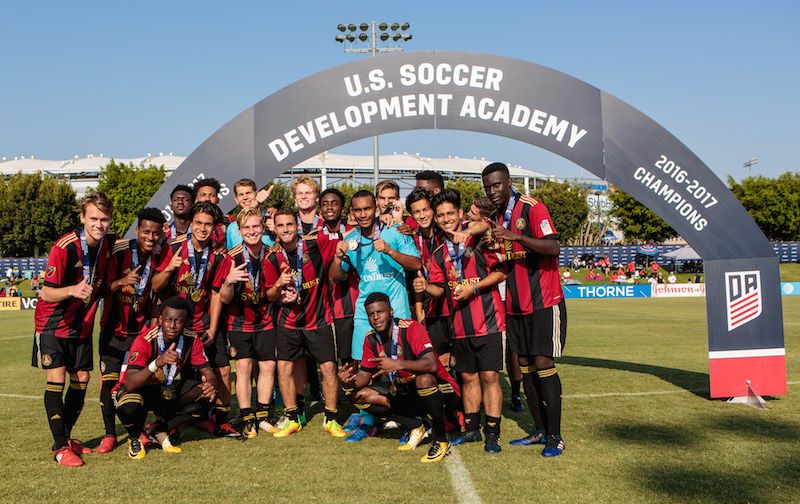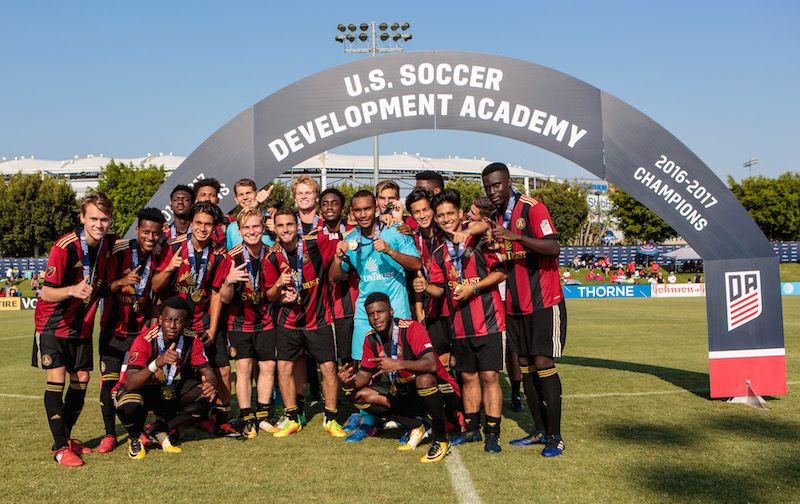WHAT IS THE DEVELOPMENT ACADEMY?
Following a comprehensive review of the youth soccer landscape in the United States, U.S. Soccer launched the Development Academy in 2007 to create a more structured player development environment for elite players to develop to their highest potential. The review was based on extensive analysis of international soccer clubs, other sports training environments, education and other disciplines that require dedicated training and practice. From the onset, the program’s mission has been to impact everyday club environments in order to develop world-class players.
The program's philosophy is based on increased training and less total, but more meaningful games using international rules of competition. Individual development of elite players is prioritized over winning trophies and titles. The Academy is the highest level of youth soccer in the U.S. and the program works to ensure elite environments to maximize youth player development nationwide.
HOW DOES IT WORK?
The 2017-18 season will feature 197 total clubs and 900 teams across six age groups: U-12, U-13, U-14, U-15, U-16/17 and U-18/19. Teams compete in three conferences: West, Central and East. The conferences are divided into geographic divisions of six to 15 teams. A full list of teams and their age group divisions can be found here, and Club maps can be found here.
The ten-month season goes from September and concludes with the Academy Championships in July. The campaign is highlighted by seasonal showcases, where teams from across the country gather to compete. Every Academy team plays between 25 and 30 total games throughout the season, broken up by a winter break and a futsal period. The teams that advance from the Summer Playoffs will play up to three additional games. Events are a hotbed for scouts, both from the U.S. Soccer National Team program as well as the collegiate and professional ranks (both domestic and abroad).
PATHWAY TO THE NATIONAL TEAM
A U.S. Soccer player development initiative, the Academy provides a clear pathway for individual players to reach their full potential and ultimately, the National Team programs. Ninety-two percent of Youth National Team players in the 2016-17 cycle came from Academy clubs.
Every game at seasonal Academy showcases are scouted, and over 50% of the season’s games are scouted by U.S. Soccer Technical Advisors. These 11 regional administrators connect Academy directors directly to U.S. Soccer and oversee the region’s talent identification network in order to bring players into the National Team fold.
ACADEMY ASSETS
With fewer total games in favor of more meaningful contests, training is the priority, as clubs are required to train at least four days a week during the season to further individual development.
These training environments are headed by professionalized coaches: all Academy coaches are required to hold a U.S. Soccer “B” coaching license and all Academy Directors must hold an “A” license. Training at Academy clubs also takes advantage of cutting-edge sports performance technology. Clubs use video analysis, performance-based player testing, perceptual-cognitive training and more to give players the best-possible developmental environment.
U.S. Soccer is also making efforts to reduce pay-to-play through the Academy program. Since 2008, the Federation has given over two million dollars in scholarship money to over 1,500 Academy players. This money has allowed more players than ever access to the nation’s highest-level of youth soccer. Twenty-three Academy clubs were fully-funded in 2016-17, meaning players don’t pay at all to train and develop in a world-class environment.
U-17 MNT: BUILT BY THE ACADEMY
The U-17 Men’s National Team competing at this fall’s U-17 World Cup in India is constructed from Academy products. Eighteen of the roster’s 21 players come from Academy clubs, and overall, the squad represents 20 clubs and 55 seasons of Academy experience.
After shining on the Academy stage, several players are now competing at the world’s highest level of youth soccer. Andrew Carleton won last season’s Development Academy U-15/16 Championship with Atlanta United FC. After scoring two goals to clinch the Academy title a few months ago, he has directly contributed to half of the team’s total goals in India. Bryan Reynolds also won an Academy championship with the FC Dallas U-15/16 squad in 2016.
D.C. United’s Chris Durkin and Sporting Kansas City’s Jaylin Lindsey were named to Academy Conference Best XI’s in 2014-15 and 2015-16, respectively, and are now key contributors for the U-17s. A third of the roster’s 18 Academy players – Carleton, Reynolds, Lindsey, Durkin, Chris Goslin and James Sands – have signed professional contracts as M.L.S. Homegrown players.

